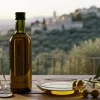The olive tree, one of the Mediterranean’s most ancient witnesses, has stood for thousands of years. Its trunk bears the marks of history, and its branches carry the bounty of life. Yet, the journey to the captivating aroma and healthful qualities of olive oil is the result of a meticulous rhythm that unfolds across the seasons. Have you ever wondered what happens to the olive tree throughout the year or the stages it undergoes before reaching our tables?
Winter’s Rest: The Tree’s Quiet Preparation
In the winter months, olive trees enter a visible state of calm. Cold weather signals the tree’s rest period, a phase that directly impacts the yield of the coming year. The soil rests, and the tree gathers strength from within. A sufficiently cold winter is crucial for the tree to produce healthy fruit in the summer.
Spring’s Awakening: Hope Blossoms with Flowers
When spring arrives, olive trees come back to life. Delicate flowers begin to adorn the branches. This is one of nature’s most sensitive periods, as these flowers are the first step toward the fruit that will become olives. The strength of the wind, the balance of rainfall, and the pollination by bees all play critical roles in ensuring a bountiful harvest.
Summer’s Patient Wait: The Growth of the Fruit
During the summer, olive fruits begin to grow slowly. The changes may not be immediately visible, but a tremendous amount of energy flows within the tree. The sun’s warmth, the soil’s moisture balance, and the direction of the wind all shape the quality of the olives. Summer is the season of patience. As the harvest time approaches, the excitement of producers grows.
Autumn’s Invitation: The Moment the Harvest Begins
Autumn is the most thrilling time of the year for olive producers. The olives ripen, their colors shifting from green to purple, and from purple to black. Each region and producer has a unique harvest schedule. Early-harvest olive oils are fresher and fruitier, while late-harvest oils have a more mature and smoother flavor. The speed with which olives are pressed after harvesting is one of the most critical factors in determining the quality of the olive oil.
The Story of Labor Reaching the Table
Once the harvest is complete, the olives are pressed, the oil is rested, and then bottled. The bottled olive oil is now ready to take its place on our tables. However, behind every drop of olive oil lies the cycle of seasons, the rhythm of nature, and human effort.
Olive oil is not merely a flavor but a symbol of thousands of years of culture, a life in harmony with nature, and dedicated labor. This story, patiently woven through each season, is one of the most precious journeys from the olive branch to the table.




